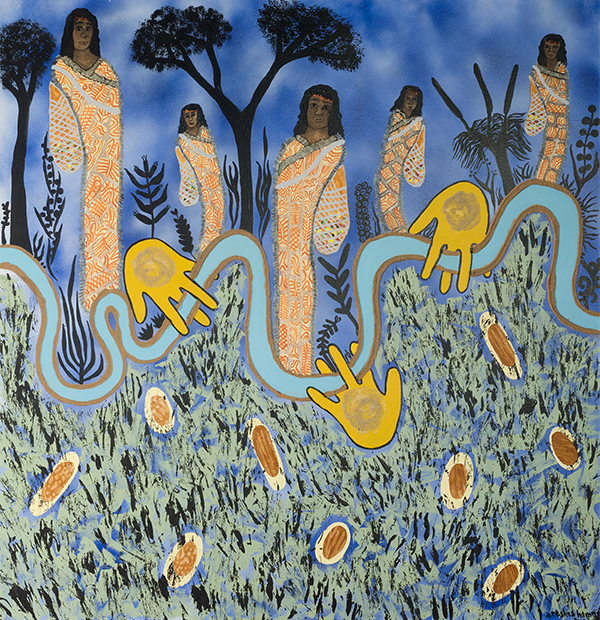The Art of Healing: Australian Indigenous bush medicine

Medical History Museum, University of Melbourne, Melbourne
Monday 23 April to Saturday 2 March 2019
Bush House, King’s College London
14 May - 28 June 2019
The Berlin Museum of Medical History, Charité – Universitätsmedizin Berlin
24 October 2019 - 2 February 2020
The art of healing: Australian Indigenous bush medicine follows the premise of Tjukurrpa (dreaming). It looks at traditional Indigenous healing practice as past, present and future simultaneously. It will present examples of healing practice from the many distinct and varied Indigenous communities throughout Australia. These will be shown through contemporary art practice and examples of plants and medicines.
The exhibition will be accompanied by a major catalogue with the perspectives of Indigenous communities represented. The key to this exhibition is revealing that traditional Indigenous healing is a current practice informed by the past, and an intrinsic part of the life of indigenous people in Australia. A selection of 20 works from the exhibition toured internationally to London and Berlin in 2019 and 2020.
For 65,000 years, Aboriginal and Torres Strait Islander peoples have occupied the lands, with distinct cultural boundaries defined by intimate relationships with Country.
Through contemporary art, the exhibition presents examples of healing practice and bush medicine from many distinct and varied Indigenous communities across Australia. The artworks in this exhibition tell stories of bush medicine from many parts of Australia, as an introduction to a vast bank of knowledge that precedes and parallels other great healing traditions.
“Bush medicine has always been with Aboriginal people. It was before, and we will always be making bush medicine. There are all kinds of bush medicine and they grow all over. You’ll find they’re different in each place, and we have these ones that I’ve painted.”
– Judith Pungkarta Inkamala
This use of contemporary art underlines the continuing practice of bush medicine, by revealing it through a current lens. It also demonstrates visually the distinct and varied cultures that make up Aboriginal and Torres Strait Islander Australia.
Many of the works in the exhibition illustrate particular bush medicines, and in their accompanying words the artists share with us their knowledge of their uses. On her Bush medicine pot Hermannsburg ceramic artist Judith Inkamala illustrates the process of preparing bush medicine. The pot is crowned with a depiction (sculpted in clay) of a knunkara (medicine woman) using a grinding stone to prepare bush medicine. Inkamala explains: ‘The old lady and the old brother will sing, sing, sing and spit into the bush medicine as they mix it. That’s why everyone will get better and everyone will become strong’.
Elder and Ngangkaṟi (traditional healer), Ilawanti Ungkutjuru Ken has created a basket based on observing birds’ nests, to show the power of family and community for a person’s wellbeing. She says: ‘My basket is like a nest.'
Ilawanti Ungkutjuru Ken (b. 1944)
Language: Pitjantjatjara
Community/location: Amata, Aṉangu Pitjantjatjara Yankunytjatjara Lands, South Australia mother’s Country: Arula
Father’s Country: near/south of Wataru
Artist location: Ingkerreke Outstation, Rocket Bore, Northern Territory
Tjulpu wiltja: bird nest basket, 2017
Tjanpi, wool, raffia, emu feathers, wire
50.0 × 60.0 × 50.0 cm
The ancestral knowledge of healing of the Yorta Yorta people is celebrated in a major work by Treahna Hamm. Dhungala cool burn shows women and girls collecting bush medicine along the banks of dhungala (the Murray River), placing the medicines in coolamons and in dilly bags.
Marilyne Nicholls’ method of coil weaving has been used in south-eastern Australia for thousands of years, to make baskets, belts, mats, eel traps and other items. Nicholls’ Healing basket is woven from Sedge fibre and includes two medicine plants: Coastal Rosemary and gum leaves, both of which are used for smoking ceremonies to cleanse and heal.
Senior Gija Elder and artist Shirley Purdie has been working for several years with linguist Frances Koford to document medicinal and other plants of the East Kimberley, identifying individual species and recording their Gija, Latin and English names. Preserving vital information and cultural memory for future generations, through written records and individual artworks.
‘Biriyal (Conkerberry or Carissa lanceolata) is used for smoking people to get away bad spirits. Used for all ages when they are sick—if they are dreaming about anything or not eating.’
Image: Dhungala cool burn, 2017, Treahna Hamm (b. 1965), acrylic paint, river sand, bark ink on canvas, 100.9 × 114.0cm (one panel)